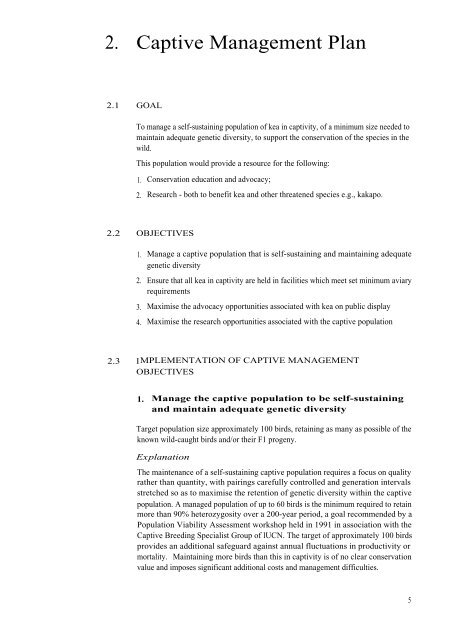Kea (Nestor notabilis) Captive Management Plan and Husbandry ...
Kea (Nestor notabilis) Captive Management Plan and Husbandry ...
Kea (Nestor notabilis) Captive Management Plan and Husbandry ...
Create successful ePaper yourself
Turn your PDF publications into a flip-book with our unique Google optimized e-Paper software.
2. <strong>Captive</strong> <strong>Management</strong> <strong>Plan</strong><br />
2.1 GOAL<br />
To manage a self-sustaining population of kea in captivity, of a minimum size needed to<br />
maintain adequate genetic diversity, to support the conservation of the species in the<br />
wild.<br />
This population would provide a resource for the following:<br />
1. Conservation education <strong>and</strong> advocacy;<br />
2. Research - both to benefit kea <strong>and</strong> other threatened species e.g., kakapo.<br />
2.2 OBJECTIVES<br />
1. Manage a captive population that is self-sustaining <strong>and</strong> maintaining adequate<br />
genetic diversity<br />
2. Ensure that all kea in captivity are held in facilities which meet set minimum aviary<br />
requirements<br />
3. Maximise the advocacy opportunities associated with kea on public display<br />
4. Maximise the research opportunities associated with the captive population<br />
2.3 IMPLEMENTATION OF CAPTIVE MANAGEMENT<br />
OBJECTIVES<br />
1. Manage the captive population to be self-sustaining<br />
<strong>and</strong> maintain adequate genetic diversity<br />
Target population size approximately 100 birds, retaining as many as possible of the<br />
known wild-caught birds <strong>and</strong>/or their F1 progeny.<br />
Explanation<br />
The maintenance of a self-sustaining captive population requires a focus on quality<br />
rather than quantity, with pairings carefully controlled <strong>and</strong> generation intervals<br />
stretched so as to maximise the retention of genetic diversity within the captive<br />
population. A managed population of up to 60 birds is the minimum required to retain<br />
more than 90% heterozygosity over a 200-year period, a goal recommended by a<br />
Population Viability Assessment workshop held in 1991 in association with the<br />
<strong>Captive</strong> Breeding Specialist Group of lUCN. The target of approximately 100 birds<br />
provides an additional safeguard against annual fluctuations in productivity or<br />
mortality. Maintaining more birds than this in captivity is of no clear conservation<br />
value <strong>and</strong> imposes significant additional costs <strong>and</strong> management difficulties.<br />
5












